Fauna of Honduras
The republic of Honduras, is a Central American country, geographically situated inside the tropics, this habitat allow thousand of species to adapted easily to its lands, therefore has a wide variety of flora and fauna species, human species between them.
Many of these species find in road of extinction, which has posed to the Honduran government, offices and naturist organizations that promote and look after the protection so much the biodiversity of species, like the existent natural reservations.
Fauna in Honduras is very rich and varied being the most common the ones of arboreal life and those that live in the fluvial currents lacustrine waters.
Big animals are not very numerous but there are hundreds of reptilean species, amphibians and birds; lizards and a lot of varieties of fish in the currents. Cute, bats and myriads of birds abound in the trees.
Climate
Since there is not cold station, thousands of varieties of insects grown on Honduras: wasps, ants, mosquitos, zancudos, jejenes and others.
Mamiferos
Between the mammals find :
- "Danto" Or Tapir (Tapirus bairdii),
- Wild boar or Pecarí (Tayassu pecari),
- Jagüilla (His americanensis),
- Tiger or jaguar (Felis onca),
- Cougar (Felis concolor), Tigrillo (Felis pardalis),
- Wildcat or Caucel (Felis Wiedii),
- Yaguarundi Or small cougar (Felis yaguaroundi),
- Bat (Vampirus spectrum),
- pizote Alone (Nasua narica),
- mapachín (Procyon lotor),
- I dare anteater (Myrmecophaga tridactyla), etc.
Birds
_(2495402213).jpg)
Avifauna is varied and very abundant between which find :
- Colibríes or sparrows in more than 20 different species; One of them is the emerald colibrí,a sparrow endemic specie Honduras
- The viudita (Trogon rufus),
- The bird carpenter (Phleoceastes guatemalensis),
- The lechuza (Pulsatrix perspicillata),
- The tecolote (Ciccaba virgata),
- The Tucán or beak of razor (Rhanfastus sulfuratus and Pteroglosus torcuatus),
- lora Yellow nape (Amazon ochrocephala),
- perico Green of the coast (Aratinga finschi),
- King zopilote or condor centroamericano (Sarcoramphus pope),
- Eumops glaucinus.
Reptiles
There are 264 species of reptiles known from Honduras, including 59 species that are endemic to the country. These include chrocodilians (two species, the spectacled caiman Caiman crocodilus and the American crocodile Crocodylus acutus), lizards (103 species), snakes (142 species), and turtles (17 species).[1]
The reptiles include the following:
- Cmmon lancehead Bothrops atrox
- Hognosed pitviper Porthidium nasutum
- Common northern boa Boa constrictor imperator
- South American rattlesnake Crotalus durissus
- Brown basilisk Basiliscus vittatus
- Green sea turtle Chelonia mydas
Amphibians
There are 137 species of amphibians (frogs, toads, salamanders, and caecilians) known from Honduras, including 52 species that are endemic to the country. Anurans are the most species-rich group (97 species), followed by salamanders (38 species) and caecilians (2 species).[1] While new species are still expected to be discovered, chytridiomycosis and deforestation are threats to the amphibian fauna.[1] At least one species, the frog Craugastor chrysozetetes, is believed to be extinct.[2]
Coral
The coasts of Honduras, find bathed north and east by the Sea Caribbean and in the south by the Gulf of Fonseca, in the next turquoise waters to the Sea Caribbean can appreciate by means of diving the Coral reefs with his diversity of calcareous seaweeds, red seaweeds, (Rhodophyta), like marine meadows, between other aquatic plants that tackle a natural ecosystem.
Between the fauna that can find in the Honduran coasts, are the Shark whale, dolphins, variety of tropical fish, shrimps (Caridea) and a lot of species more
| Biodiversity of Honduras | |||||||
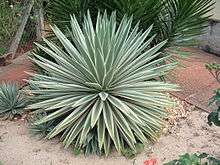 |
 |
 |
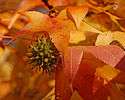 | ||||
| Agave | Tillandsia flabellata | Anthurium | Liquidambar | ||||
 |
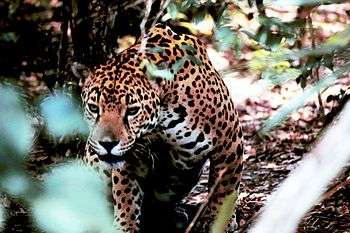 |
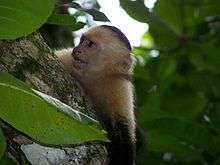 |
 | ||||
| Dolphin | Jaguar | Cebus capucinus | Tayassu tajacu | ||||
 |
.jpg) |
 |
 | ||||
| Iguana | Boa constrictor | Caretta caretta | Cephalopholis fulva | ||||
 |
 |
 |
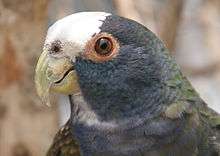 | ||||
| Tucan | Plough ambiguous | Harpia harpyja | Pionus senilis | ||||
See also
- Flora and fauna of Honduras
- Birds of Honduras
- Annex:Reptiles of Honduras
- Ecology of Honduras
- Annex:national Parks of Honduras
- The Arboretum of Zamorano
- Geography of Honduras
- Botanic garden Lancetilla
- Reservation of the Biosphere of River Banana
- Office of Natural Resources and Environment of Honduras
- National park The Tigra
- Honduras
- Climate of Honduras
- Agriculture of Honduras
- Education in Honduras
- Fauna of Argentina
- Fauna of Mexico
References
- 1 2 3 McCranie, James R. (2015). "A checklist of the amphibians and reptiles of Honduras, with additions, comments on taxonomy, some recent taxonomic decisions, and areas of further studies needed". Zootaxa. 3931 (3): 352–386. doi:10.11646/zootaxa.3931.3.2.
- ↑ Cruz, G., Wilson, L.D. & McCranie, R. (2004). "Craugastor chrysozetetes". IUCN Red List of Threatened Species. IUCN. 2004: e.T56513A11488131. Retrieved 17 June 2016.
- Decree No. 104-93 issued by the Sovereign National Congress of Honduras (consulted 2012).
- General law of the Environment and General Regulation of the Environment, Office of the Environment, Publisher Guaymuras; Honduras, 1995.
- Database biodiversity in Honduras Wild Honduras (consulted 2012).
